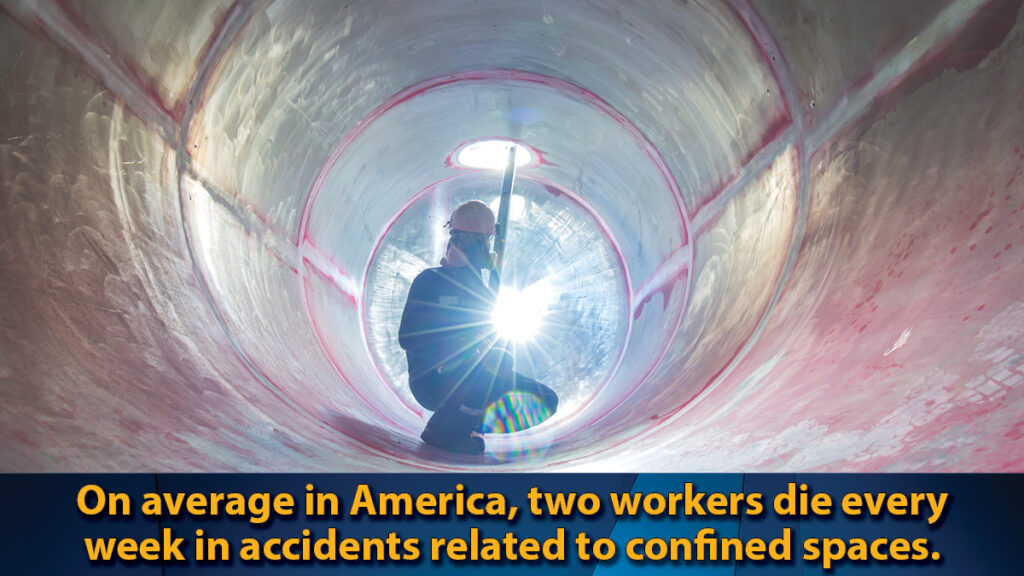A confined space is an enclosed area that is not designed for human occupancy but may require workers to perform work or service. They may have limited entry or exit, unguarded machinery, exposed wires, limited airflow, or may house a hazardous atmosphere. Enclosed spaces can be dangerous because of invisible, odorless, hazardous gasses or low oxygen levels due to the build-up of CO and CO2 gases.
Many fatal accidents, especially in the construction industry, have occurred due to improper safety procedures or not using appropriate safety equipment. Therefore, it is critical to train workers to identify these unsafe locations on your job site, the dangers associated with each, and avoid them altogether if possible.
Examples of confined spaces:
- Access shafts
- Aircraft wings
- Barges
- Chimneys
- Cold storage
- Culverts
- Digesters
- Ditches
- Ductwork
- Equipment housings
- Fish holds
- Grease pits
- Hoppers
- Inside of boilers
- Manholes
- Manure pits
- Pipes or Pipelines
- Pits
- Pump stations
- Sewers
- Shipping containers
- Silos
- Storage bins and tanks
- Subcellars
- Trenches
- Truck or rail tank cars
- Tunnels
- Underground electrical vaults
- Utility holes
- Vats
- Vaults
- Vessels
- Water supply towers
- Wells
Confined Space Statistics:
From 2011 to 2018, 1,030 workers died from occupational injuries involving a confined space, according to the U.S. Bureau of Labor Statistics. The annual figures include a low of 88 in 2012 and a peak of 166 in 2017. In 2014 90 deaths happened involving confined spaces, and 40% involved attempted rescuers. In 2017, two workers died each week because of entering a confined space.
Common Hazards in a Confined Space:
- Hazardous gases and vapors, carbon monoxide, carbon dioxide, Freon, hydrogen sulfide, welding gases, ammonia, etc.
- Asphyxiation due to limited oxygen
- Combustible specks of dust
- Flammable liquid or gases
- Explosion
- Engulfment
- Becoming trapped
- Fall hazards
- Rescuer death
Create a strategic plan—a documented system to help workers communicate and stay on the same page.
After you have eliminated unnecessary dangers, employed lockout/tagout to isolate electrical or mechanical risks, and found ways to avoid entrance into these danger zones, you need to use the proper safety equipment. Once you know what dangers exist, use gas detectors that monitor dangerous gases and vapors.
Gas monitors pick up on the hazards that you can not touch, see, hear, smell or taste. These detecting devices record concentration levels and changes in the environment and communicate them to the worker and the confined space team members outside.
Job sites are constantly in a state of change, and hazardous atmospheres can develop at any time. Typically, you won’t see, feel or smell anything, so invisible danger needs to be on your radar all the time. The use of a gas detector to check for combustible gases (LEL), carbon monoxide, hydrogen sulfide, and oxygen is essential.
Revisit your logs and see when gas detection devices were last calibrated, check the performance and accuracy of devices and sensors, as well as maintenance records. Also, be sure to perform daily bump testing—a simple process that exposes the sensors in a gas detector to a greater concentration of gas than the set alarm point.
Working as a Team is Paramount.
No worker should ever go into a confined space without a team monitoring from the outside. The second team member must know the hazards of the location and communicate with the entrant to ensure safety. They are also responsible for evacuation and rescue procedures. The third person on the team is the supervisor. The supervisor oversees safe entry, including determining if entry conditions exist, authorizations, overseeing entry operations, terminating entrance, and canceling any current entry permits.
In Conclusion:
Workers need to know what a confined space is. Then they can learn how to detect a confined space, what precautions to take and how to protect themselves and their crew. The risks in a confined space are dangerous, and a lack of knowledge and understanding will be deadly.
Be sure the proper safety procedures are in place by evaluating the task, the working environment, the materials and tools needed, the precautions to take, the safety equipment to use, and the rescue plan in place.
Delve into the following standards and regulations for further information regarding confined spaces:
- OSHA 1910.146 Permit-Required Confined Spaces
- ANSI / ASSE Z117.1 Safety Requirements for Confined Spaces
- OSHA 1926 Subpart AA-Confined Spaces in Construction

